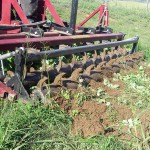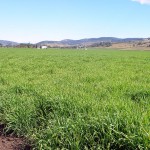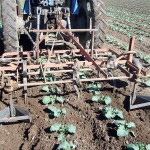At Mt Whitestone Farms, we know that the quality of our veggies depends on the Australian Demeter Bio-Dynamic Method. The way we implement Demeter BD principles influences the quality of soil which, in turn, affects the tastiness of the end product.
Soil preparation
 We start preparing our soil for the next planting as soon as harvesting has been completed.
We start preparing our soil for the next planting as soon as harvesting has been completed.
- The still-green brassica plant remnants are mulched using a PTO mulcher.
- A mix of rock dust, cow manure and gypsum is spread over the mulch. We use approximately 0.5 to 1 tonne of rock dust (a 50:50 mix of granite and basalt), 3 tonnes of cow manure and 300 to 500 kg of gypsum per acre.
- A rehabilitator plough is used to incorporate the mulched crop residue and natural inputs into the soil.
- Green manure crops are then sown.
- Prepared 500 is sprayed when soil moisture conditions are optimal. We spray twice per year.
Green manure
 Any given paddock may grow green manure crops for up to two years before a production crop is grown. Green manure assists soil preparation by introducing a healthy source of humus.
Any given paddock may grow green manure crops for up to two years before a production crop is grown. Green manure assists soil preparation by introducing a healthy source of humus.
- Dolichos lablab, a warm climate legume, is sown coming into summer.
- Oats, barley and vetch are grown over winter.
- The green manure crop is grazed periodically over summer.
- In spring, the cattle are shut out and the crop allowed to bulk up.
- When ready, the green manure crop is mulched, then ploughed in using the rehabilitator. Gary finds that towing the rehabilitator plough at 4 km/hr works the green manure into the soil most effectively.
- The soil is left to rest, then it is cultivated with the triple K – a strongly sprung curly tyne cultivator. The triple K fines up the soil and forms three slightly raised beds, each five feet wide, ready for planting.
Planting
Usually, two green manure crops are grown in a given paddock before planting a vegetable or fruit crop.
- If weeds have germinated before planting, the triple K cultivator is used again to kill the weeds – this may happen several times.
- When it is time to plant, a roller is used to firm up the beds created by the triple K.
- Seedlings are then planted, with two people feeding the seedlings by hand into a tractor-drawn planter.
- Due to the sheer size of our operation, there is no organic seedling supplier who can provide the numbers we require. So our seedlings are sourced from conventional suppliers that have not used any pesticides. We have been granted an exception for this from the BDRI.
- We start planting brassicas in late January and continue through the end of June – a 25-week planting period.
- Each week we plant approx. 18 000 broccoli, 6 000 cauliflowers and 5 000 cabbages.
- Prepared 500 is sprayed either just before or after planting, depending on soil moisture.
Growing & nurturing
 The end consumer continues to demand produce that looks as good as conventionally grown produce. To achieve this, we grow hybrid varieties. If we grew open-pollinated brassicas, with a broad variability of appearance within each strain, most consumers would not buy them.
The end consumer continues to demand produce that looks as good as conventionally grown produce. To achieve this, we grow hybrid varieties. If we grew open-pollinated brassicas, with a broad variability of appearance within each strain, most consumers would not buy them.
- As weeds start to appear, while they are still small, a single-bed triple K cultivator is used to scuffle them between rows, and push a little soil into the row to smother weeds between seedlings.
- Any weeds that are missed are hoed by hand.
- Beneficial insects, predators of pests, are introduced mainly in spring and autumn – lacewings eat aphids and caterpillar eggs, trichogramma wasps sting cabbage moth caterpillars and other parasites attack the green peach aphid.
- Lady beetles visit naturally when aphid numbers are high.
- Predators are our main line of defence against pests – they work 24 hours a day.
- We consider Bt a backup but avoid using it if possible – it is unreliable if the temperature rises above 35°C.
- We never use natural pyrethrum (which is allowed by BDRI) as it will also kill our beneficial insects.
- We irrigate our crops using sprinklers. We found that water from drippers only soaked downward (not outwards) and root formation was restricted to the small area directly around each dripper.
Harvesting
 We pick our brassicas from April until October. The onions, melons and pumpkins are sown over summer. Onions are harvested from September until February, and we pick melons & pumpkins between late November and February.
We pick our brassicas from April until October. The onions, melons and pumpkins are sown over summer. Onions are harvested from September until February, and we pick melons & pumpkins between late November and February.
- All our harvesting is done by hand. Pickers walk up and down the rows, pick the produce and pass it to packers on the back of a truck.
- Cauliflowers and cabbages are packed straight into boxes ready for transport.
- Broccoli is placed into large bins and later packed into styrofoam boxes with ice for transporting.
- Our produce is sent to organic wholesalers in Brisbane and Sydney, and to the Bio-Dynamic Marketing Company in Melbourne.
